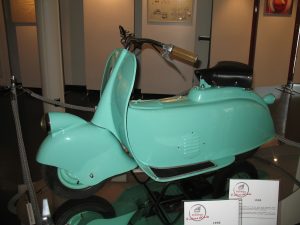Innovative technical solutions and a lot of foresight led to a myth on two wheels that, 73 years later, still runs.
It was April 23, 1946 when Piaggio & C. Spa filed with the central patent office for inventions, models and brands of the Ministry of Industry and Commerce in Florence, the patent that would revolutionize the way to move from below, both in Italy and in the rest of the world. We are talking about the Vespa, a real icon of Made in Italy, filed with the patent office as “motorcycle with a rational complex of organs and elements with frame combined with mudguards and bonnet covering the entire mechanical part”.
The name seems to have come from Enrico Piaggio, who at the sight of the first prototype exclaimed “it looks like a wasp!” because of the sound of the small two-stroke engine and the shapes of the bodywork that, seen from above, reminded us of the insect. 
The right man in the right place, then, who would surely have created something innovative. D’Ascanio, who hated having to climb over a motorcycle in order to sit on it, put his extensive knowledge of aeronautical construction to good use, thus inventing the first load–bearing body motorbike, without tubular steel structures, like all the motorcycles of the time.
The aeronautical world is closely related to the creation of the Vespa. First of all, up to that moment, and also for the years to come, Piaggio had always produced planes, often with remarkable performances, but above all engines that equipped the vast majority of the fighter planes of the Regia Aeronautica. The construction with the load-bearing body, the front suspension of the Vespa, which was directly derived from that of the airplane landing gear, is a direct reference to the world of aviation. D’Ascanio moved the gearbox to the handlebar and covered the engine with the frame to remedy the frequent oil leaks that stained the pants, as for his ancestor MP5.
A spare wheel was also added, since most of the post-war Italian roads were unpaved, and motorcyclists were forced to remedy the frequent punctures with glue and patches. Particular attention was paid to ergonomics, with the driving position modeled around the design of a seated man, so that prolonged driving would be less tiring. With the help of his trusted designer, Mario D’Este, Corradino D’Ascanio was able to fine-tune the project in just a few days. A few months later it was presented to the public, and it was Enrico Piaggio himself who started the production of a first batch of two thousand Vespa models, 98cc displacement.
Sales price: 55,000 lire for the “normal” type and 61,000 lire for the “luxury” type with some exclusive options, such as the odometer, the side crutch and the tyres with the characteristic white band. At first, the insiders did not agree on the goodness of the idea. But the skeptics would soon change their mind, including Count Parodi, manufacturer of Moto Guzzi, who had initially branded the new means of transport as a product of little success. The last months of 1947 saw a surge in sales, with the release in 1948 of the Vespa 125. A positive balance, considering that in 1946, a year after the end of the war, Piaggio put on the market 2,484 scooters, in 1947 10,535 and almost 20 thousand in 1948.